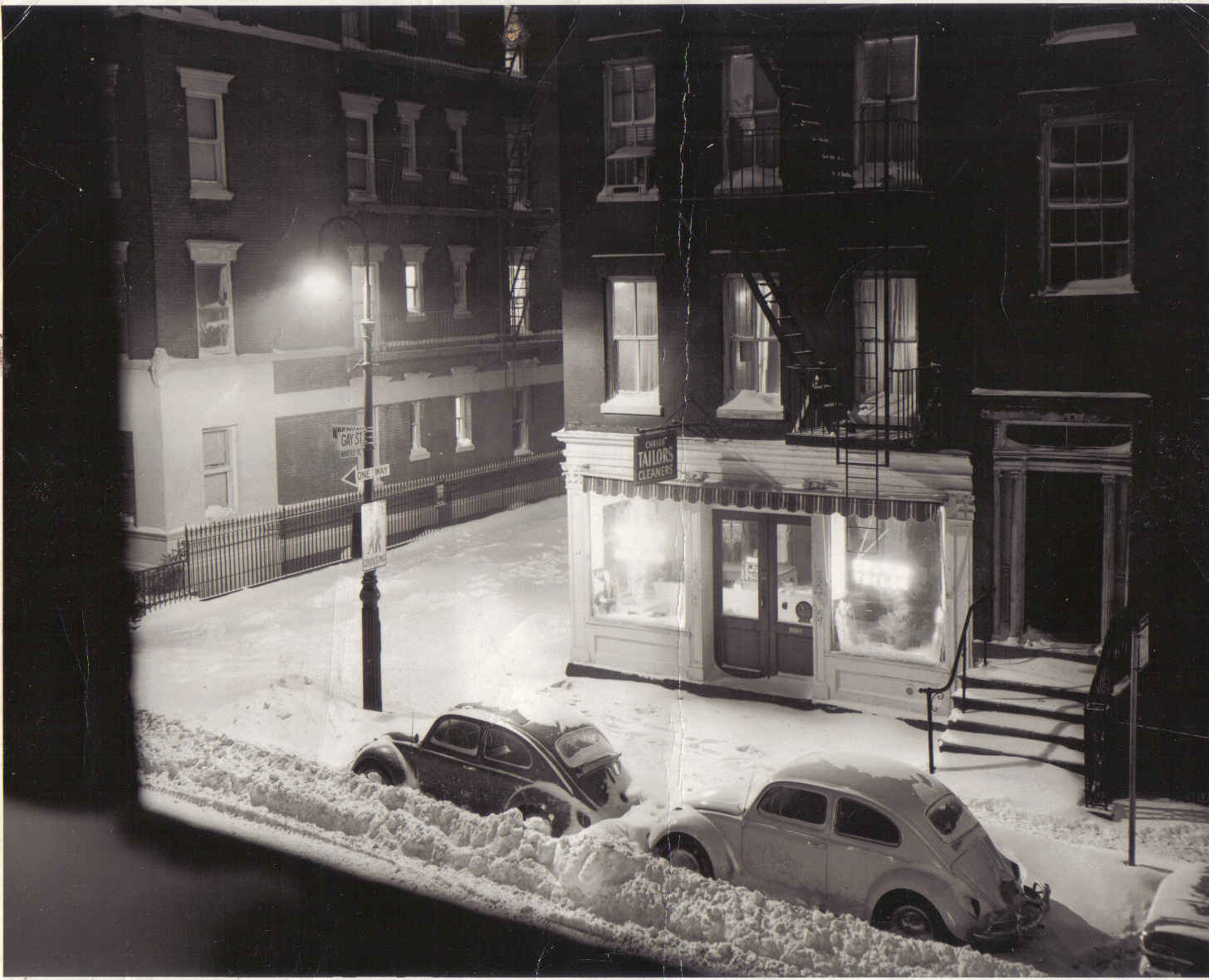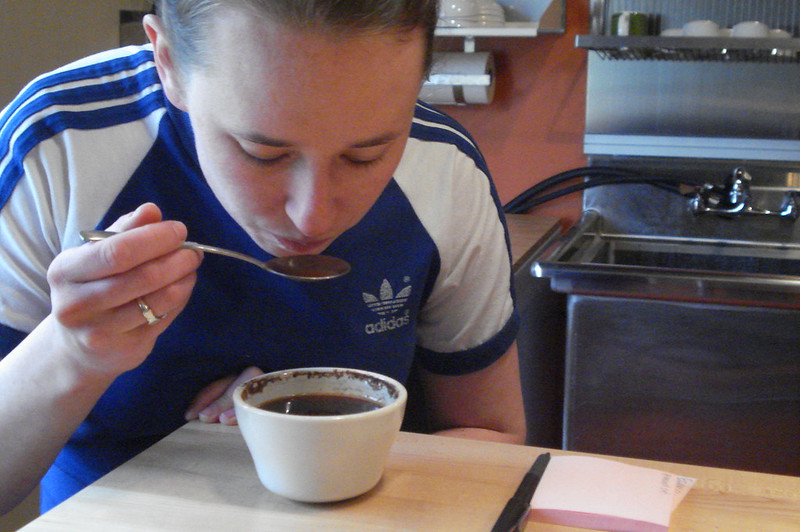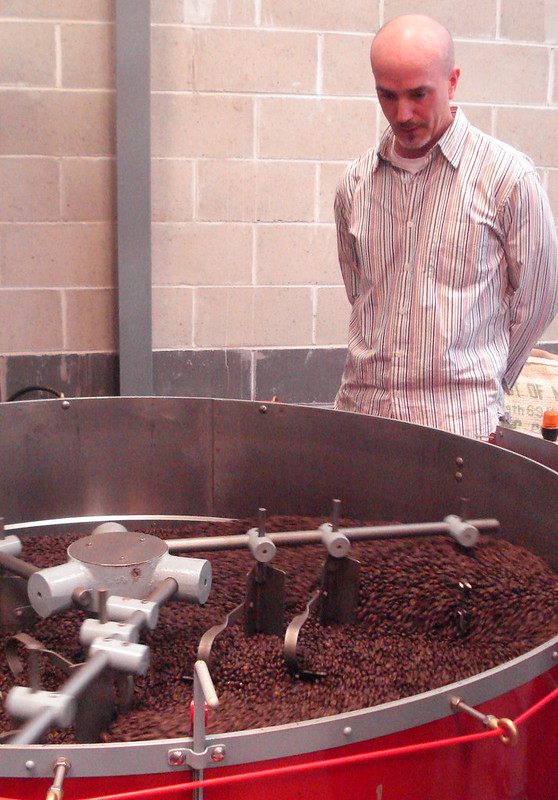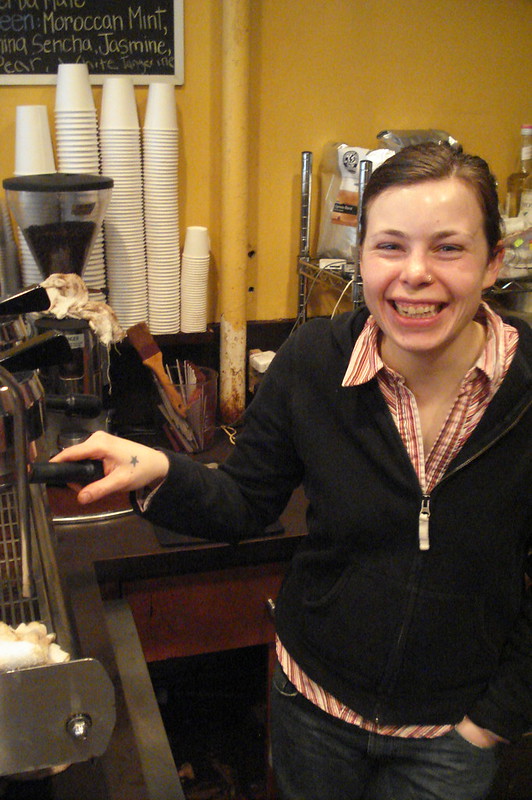We're talking to the folks behind the coffee you love to find out how they got there. How they turned their individual passions for crafting the perfect cup of coffee into small businesses sharing their coffee within their communities and beyond. The road is long, often challenging, but always well worth it — this is how they made it happen, these are their Founders' Stories.
This week, we get to know Jonathan Rubinstein, whose dream of opening three coffee shops in New York City eventually grew into the incredible roaster-retail success story known as Joe Coffee Company. Jonathan talks about learning everything from the grounds up, and recalls being one of a small handful of specialty-coffee cafés in Manhattan in the early 2000s. Today, Joe has a full-scale roasting operation, wholesale customers across the United States, and 22 retail locations that continue the tradition of incredible hospitality and high-quality coffee that Jonathan and his family started 19 years ago in the West Village.
From zero knowledge to third wave in one year
“I have no memory of my parents drinking coffee. And if they did, it certainly wasn’t in any different way than anyone else consumed coffee in the suburbs of wherever they lived. They were not people who like mail-ordered Peet’s Coffee or anything like that. In the mid-90s I lived in Cleveland, and I remember when the first Starbucks opened there and they were definitely destination places, and I partook, but drip coffee — I think for the caffeine.
I think my first interest or taste in coffee was probably a year before Joe opened, when I would run down from my corporate job in talent management to a coffee place on 57th Street and used it just for the fuel — and to wash down my cookie, is what I remember. But there was no knowledge or interest in any way, real interest, until I decided to open a café and then try to learn about it, initially through our friends from Barrington Roasting Company. My hunch is that I had never tasted espresso or any espresso-based drink before I decided to open Joe. I mean, there was no such thing as quality coffee in New York City before — at least before we signed the lease. The question of whether or not… Ninth Street Espresso was first — if they were first, they were months before we were. There was no opportunity to taste good coffee. It was the time when Starbucks was at its height, and bodega-slash-Greek diner coffee was how you consumed coffee, or you went into Greenwich Village and had old-school Italian café on MacDougal Street. But there was nothing that was of the quality that people think about with specialty coffee, so no, I didn’t know anything about it whatsoever.
I had been in like an office job that I hated, and everything that I had done prior to that I always was the boss or the creator of what I did. I came to New York and worked for other people and it wasn’t the right fit. I remember when I left the job, which was August of 2002, I made a list of things that just sounded romantic, because I was young enough — I think I was 32 — that I didn’t think about long-term career or finances, I just thought about what I wanted to do then. It was a bakery or a yoga studio, or a coffee shop, or a day camp. And that one [coffee shop] just kept sort of surfacing at the top because I knew I wanted to be sort of entrepreneurial. Then when I stumbled upon the space that became Joe on Waverly Place, I just remember it was like kismet because it was in my eyes the perfect location for the way I dreamed a café should be. You know, this historic street of Waverly and Gay Street by NYU, and it had a patio and exposed brick, and I would see interesting artists and writers and actors in the neighborhood when I would walk around or sit in front of the space and the rent was affordable. I remember so well, it was $6,750 a month. I made an offer and the landlord accepted it. He’s still the landlord and we have a very friendly relationship after 19 years, and just sort of said, ‘I guess this is what I’m doing! Let me learn everything I can and figure out how I can make this better than or different from other coffee places in New York.’ And that was how the journey started. It wasn’t particularly culinary because I wasn’t a subject expert, I didn’t know anything! But I was willing to learn, and I knew the differentiator was going to be the hospitality — though we didn’t call it hospitality then, we called it customer service — so the customer service and the quality of the coffee. That’s how it started.”

Finding the right teachers
“Everything I learned, I learned from Barrington Coffee Roasters, and I learned because Amanda Byron, who had worked for them and was from Seattle, had moved to New York to become an actor. When she was introduced to me by Barth [Anderson] and Gregg [Charbonneau] of Barrington Coffee Roasters, she taught everything or orchestrated the knowledge for me and for everybody on staff. ![Amanda Byron]


What happened is that my sister, who is my partner and who still works with us as my partner, she had been an opera singer and she’d done a summer at Tanglewood in the Berkshires. And when I told her about my idea [to open a coffee shop], she said, ‘Oh my gosh, I discovered this incredible coffee place called Lenox Coffee,’ which has a shared ownership with Barrington Roasting. They used Barrington’s beans. So I drove up to Massachusetts—again, knowing nothing — and Barth Anderson poured me a latte that was literally life-changing. I actually remember the experience of it because I had never had at least a quality espresso drink, I’d never seen latte art, I’d never had an espresso drink poured in porcelain. So this just totally rocked my world.
Again, back then it isn’t like I could shop around to Blue Bottle and Stumptown and Sweet Leaf and see who would be the best roaster to work with—there was nothing here, there was nothing local. This was all I knew, and I thought it was amazing and Barth was an incredible mentor and has the most incredible energy. He kind of took on this role as well of advisor. And that’s how we came to work with Barrington Roasters for the first I think 6 years of Joe. We didn’t look any further.
That was probably March, and we ended up opening in July, so we had three or so months of learning with him and getting his knowledge and expertise, and how in the world to design and devise a menu. One of things I remember so well was we were trying to pick our espresso machine. We had such limited money ,and we were debating between a La Marzocco which at the time was like, ‘Oooh,’ no one had them because they were so expensive, and a Cimbali, and Barth sort of saying, ‘For the difference of like $3,000, do you want the Rolls-Royce of machines that will make a statement of what you are, or do you want what everybody else has?’ So we made the priority, I think at the expense of getting a computer for the store, and we were going to buy this Marzocco. I remember this so well at the time, all of the early press on us, and all the awards and things always focused on the fact that we had a Marzocco because it was so unique. Again, now, a dime a dozen at best, but it was such a big deal then.”
Growing a coffee shop into a “business”
“I never called it a ‘business’ because originally it was just going to be a café. I do remember the joke among those of us who were there the first year, ‘Wouldn’t it be cool if there were three of them?’ And I would manage all of them. That was the aspiration. I was going to work behind the counter forever — which, you know, sounds amazing now in some ways, I’m serious—and know all the regulars and the 25 people who would work among the three. But in the beginning, that first year and a half, it was just that one café because, again, we didn’t know what we were doing: We didn’t have systems, we didn’t have any of the building blocks of what we now call a business. It was just flying by the seat of our pants at this café that was magic because of the amazing people who worked there.
All these good things come together coincidentally: The fact that we were in the Village and right near us happened to be regulars who wrote for food magazines, and celebrities came in that magazines liked to write about. It became such a destination because it was unique and because it was magic and because there was so much heart in it, and because of Amanda and the crew at the beginning who were family — the kind of thing that you just don’t recapture in the same way anymore.
When we opened a second location, it generally felt still special, but it was a little bit different because those of us who were running things weren’t behind the same counter every single day like we had been. I do remember that until we had a second store, I did myself open Waverly Place at 6:45 in the morning. I took off Sundays and my sister opened. But I wasn’t willing to give up control and I loved it. I remember, to save on labor, I would get there myself at 6:45, and then at 6:55 — because every 5 minutes of the time card made a difference when you didn’t know if financially it was gonna work—the second person would come at 6:55 and 5 minutes later we would open the doors. The 6:55 person’s job was to put out the Tom Cat muffins in lines — which took like an hour and a half because in 2003 everyone ate a muffin. We’d go through like 250 muffins, now we sell like 6.
There was no strategy [to expanding], there was no, ‘We’re gonna target these neighborhoods.’ After a year and a half I sort of said, ‘I think we’re ready for a second,’ and stumbled upon what became the second, on East 13th Street. And then it slowly — it became a little bit of an addiction, and I became an opportunist, and you start to see the more you open, the more you can see people who started as baristas in quote-unquote we used to call them ‘real jobs’ with health insurance and salaries. And then it became about one a year.
We didn’t think about profits, we just wanted to survive and potentially open more. Again, what I also remember from the very early days was the first salary was exactly $400 a week, which everybody thought was real money, it was $20,000 a year, plus tips because it was still legal for general managers to take tips, and that was it! Everybody else, the starting wage was $8 an hour, and then when you were cleared on bar it was $9 an hour plus tips — which could be extraordinary at the time, they could be $10, $15 an hour. But it was such a different world. The other thing that’s so funny that I remember is that the majority of the people who worked at Joe lived in Manhattan. Like, A, who lives in Manhattan, and B, who can afford to live in Manhattan?! That’s what baristas did! I hate to sound like this old person looking back but I do.”
Becoming a roastery
“It was pretty late in the game when we started roasting — I think it was about 2011 maybe? That was 7 or 8 years into the business, half of our life. That happened because we had talked about it forever. And all of a sudden, other people were coming to New York and they were roasting, and they were getting a lot of accolades for it and people were starting to say, you know, especially the staff were saying, “I want to understand the whole supply chain,” not just see 5-pound bags of coffee come from Barrington and then Ecco Caffe in Santa Rosa, from Andrew Barnett.” And it was Ed Kaufmann, who was a friend of Joe and a friend of all of ours, who sort of one day said, “I think I’d like to start a roastery with you.”
So I called Steve Mierisch, who had been our rep at Intelligentsia — which had bought Ecco — and said, ‘Here’s this crazy idea.’ He said, ‘I have an idea for starting a shared roastery,’ and we sort of hatched the idea together and I said, ‘Let’s try it. I trust Ed.’ Again, not knowing anything about green buying or logistics in or out, or blending, I mean nothing. We trusted Ed because he was Ed and he worked at Stumptown, and Stumptown was everything. We just thought we would sort of take the plunge. It had worked for us in sort of everything we had done before: Open, become more than one store, start the catering business, start public [education]. We just sort of said we’d try it. The risk seemed low enough and the upside sounded great.
I was feeling at that point that others were in New York and were maybe doing it better than we were doing, and I didn’t like that. There was this period of time in New York where everyone knew everyone, the players were so small. It was like, ‘Specialty coffee in New York is Joe, Ninth Street, Café Grumpy, and Gimme! Once the big players started coming in from other cities, that was really scary. We were losing attention and we were potentially losing customers and opportunities, and what were we gonna do so we just weren’t this sort of latte-slinging, lines out the door, but that’s all we were sort of doing? That seemed to be potentially the solution, which it was. It opened up a million doors for us — everything from the investment in 2017 with Union Square Hospitality Group, which definitely wouldn’t have happened, to our wholesale program, to Trade, and to maybe keeping us alive during the pandemic.
It was like such a Ma and Pa, Ed and one or two other people there just figuring it out. No checks and balances, no buying strategy, no thought about pricing to what’s become a pretty sophisticated, roughly 20-people department that’s huge for us. Like everything else, you just kind of figure out over the many years by surrounding yourself by people who are really good at it, who are better than you and are experts and have this combination of the subject matter expert and the work ethic, and also this understanding of what makes us us, and what our values and culture is, has become organically, and is ready to sort of grow the business in ways that I never would have thought would happen, nor could I do really myself in any way. Not just myself, but could I even lead? Ask me to work a shift behind the counter and I’d destroy the flow, it would be a disaster shift. Ask me to turn on a roasting machine and I’d be like, “Where? Is there a button?” But the other people are so good at what they do and I support them and trust them and try to strategize with them I think.”
What makes Joe Joe
“I think a lot of what makes Joe Joe is the history. That sort of magic, what you think of Pike Place Starbucks or James [Freeman, founder of Blue Bottle Coffee] at the farmers market in San Francisco. I think it’s our history in being at least one of the pioneers in doing this and ending up having, I would probably say millions of people who have become Joe regulars over the years. When you think about 19 years, maybe 1/3rd of most people’s lives, who started coming in when they were in college and now they’re in their 40s, or when they were kids and now they’re adults, or whatever the case is. Nineteen years is a lot of years!
Going back to the beginning, I also so distinctly remember the night before we opened in 2003, we had the only staff meeting and training because we were still building out Waverly Place. And my big speech was like, ‘You go to Starbucks and you’re in New York City and everybody’s gruff and anonymous, and we’re going to become a place where we actually care about you and you become a regular and we smile and we know who you are. We become a highlight of the day and we become a significant relationship.’ Again, if I use, like, [Joe regular] Brett [Leveridge] as an example. The relationships he had, the fact that he would come in and everybody would know him and he’d have this moment of like, ‘Norm!’ He would feel good and he would feel recognized, and there are thousands of Bretts who are our customers over the years. I think it was this sincere desire to touch regular in a way that again like now there’s a formula to it and a philosophy and it’s in the handbook. Back then it was like, ‘Just be super nice.’
We want everybody to walk out of Joe and say, ‘Oh my G-d, the coffee is so good, and the people who work there make me feel so a part of it. Why would I go anywhere else?’ I think it’s that somewhat magical experience, though again it’s different with this many cafes and less of a direct touch from myself and my sister, and the fact that we’re such a part of history, and again all these millions of people who have been customers at some point in their lives, and that we’re in many neighborhoods, it works. Not that we’re this phenomenon anymore, not that we’re the best. But I think the whole equation has worked for a long enough time that we’ve actually become an institution. But it really is true. All the stars aligned.
By far my greatest joy—my greatest joy—is walking into Waverly place and seeing many people who, no joke, were there that [first] summer. It’s been 19 years, seeing them, I can’t even begin to think about how many visits they’ve had or how many relationships they’ve had there. It’s the most rewarding to walk in there and regulars from 2003, that perception that people have is like, ‘Oh my G-d, there’s Jonathan, he’s this mega successful businessman.’ They’re so proud, or like starstruck. And I’m like, ‘Wait, I made your coffee and took your garbage out all those years ago.’ They can’t believe I remember them. And I’m like, of course! I can still tell you you’re half skim–half soy latte, extra foam. I can tell you because it’s burned in my brain, I made that drink a thousand times for you, David, and you would come in at 9 in the morning.”
Joe alumnae (the author included)
“It’s been a very, very, very long time doing this. Which is also crazy because you were there in the very beginning. [Writer’s note: I worked full-time at Joe from 2004–2007 and was one of the first store managers.]

How many people have like been through the revolving door? I don’t mean “revolving door” in a negative way, but if I could ever go back and find records to count everyone who’s been employed at Joe, now in nearly 20 years, it’s got to be in the low thousands. It’s crazy! Especially when I think back to like, I could name all of us from that first year and I wouldn’t miss anyone.
Following the stories of Will Gross and Brendan Mullally and Jess Rufo — I’m so proud of the number of cafés from people who maybe they did or maybe they didn’t get their start, but Joe was definitely a part of their world. That makes me so incredibly happy and really, really proud. Even walking into a Proudly Serving Joe wholesale account that’s doing it so well and knowing that we were part of it in the way that Barth was to us is really exciting.
Yes, people do still call me Joe, and most of them are people who have been coming in since 2003 so there’s no way I’m ever going to correct them. But I love it.


